
Birds and Orchids (part 2)
July 6th, 2017
(Part 1)
After our stop to see the Ram's Head Ladyslippers, we went to Murphy's Point Provincial Park in Perth. This is a beautiful park on the shore of Big Rideau Lake with a rather Carolinian feel to it (including, sad to say, a rather Carolinian population of ticks, I pulled one off me during our walk.) It produced our big surprise of the day. We were birding the Silver Queen Mine Trail when Jon shouted that there was a White Pelican in flight and to get our binoculars and cameras ready. I couldn't believe my ears--I thought he must be mistaken--but then I got a clear view of it. A White. Pelican. Little over an hour away from where I live.
My photos came out overexposed (the exposure having been set for a cute moth I was photographing close to ground, more on him later!) and I was bummed. But then, as if our jaws hadn't dropped enough, the pelican flew back into view and right over our heads. This time I was ready.
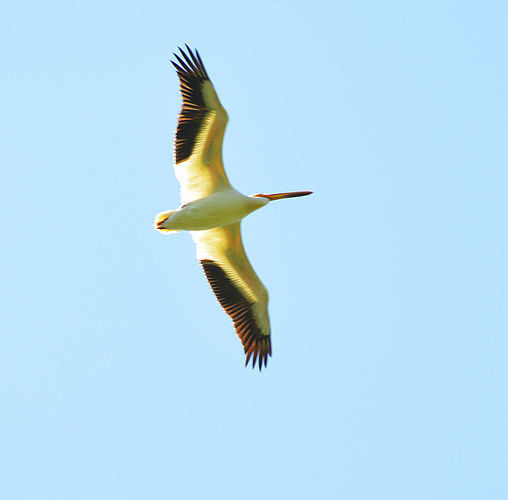
When we first arrived, the park staff asked us to let them know if we found any rarities for the park. We found not merely a rarity, but a bird that is a second-ever for all Lanark County, in recorded history. White Pelicans are a western species whose breeding range touches only the extreme western tip of Ontario. This would have been a very lost, late spring migrant! It is an Ontario-first and a second-ever bird for me.
Other than that, my photo set from this trip might better be termed "insects and orchids." I saw plenty of good birds, but most of them too far away for my lens to capture at all well. (I envy those with steady-enough hands to shoot 500mm handheld!)
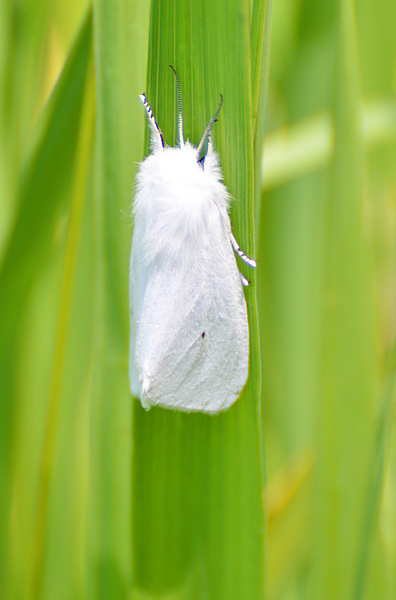
A kind of adorable furry-headed moth I found on some low vegetation. I think it's an Agreeable Tiger Moth. (That being, of course, a close relative of the Disagreeable Tiger Moth and the Cantankerous Tiger Moth. Okay, maybe not.) A lifer insect for me, to go with my lifer wildflower (Ram's Head Ladyslipper), lifer reptile (Rat Snake), and pretty-darn-close-to-lifer bird!
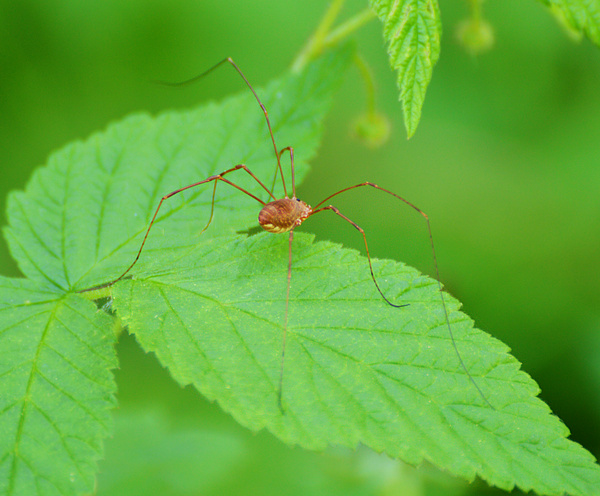
A daddy longlegs, more properly called harvestman. Harvestmen are not spiders and are harmless to humans. I've loved them since I was a child.
Our final stop of the day was Purdon Conservation Area, famous for its thriving colony of a large, beautiful wild orchid, the Showy Ladyslipper. But we arrived to find the orchids not yet in bloom. The many tall shoots promised an incredible show once they are. I plan to go back on my own (and/or with Michael) in late June, when they should be at peak. The carnivorous Pitcher Plants were also not much to look at yet. But there were a few wildflowers worth photographing.
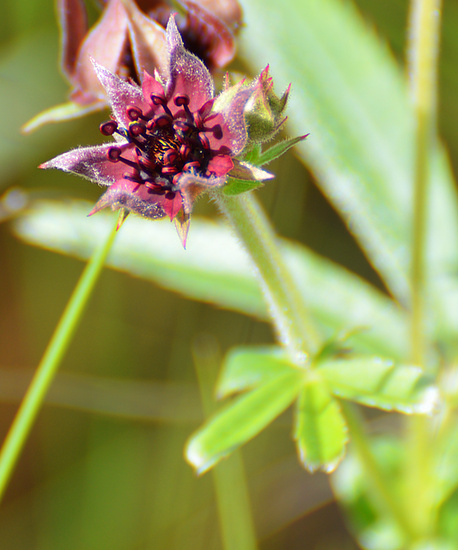
Swamp Cinquefoil

Starflower
I've noticed quite a few tent caterpillars in Ottawa this spring, but that's nothing compared to Lanark County. Sites we visited had an infestation of epic proportions, with tents and caterpillars everywhere you looked. In the trees, in the bushes, on the ground, on your backpack, on your head. The deposit box for park fees at Murphy's Point had a mass of a few dozen crawling atop it. At one spot on the trail, we heard a sound like gentle, pattering rain coming from the woods. I learned what it was the next day on Wikipedia. It was the sound of umpteen caterpillar fecal pellets falling from the treetops.
Tent caterpillars are shunned by most birds, spiny as they are, but the North American cuckoos (Black-Billed Cuckoo and Yellow-Billed Cuckoo) eat them with relish. Quoting from Life Histories of North American Birds by Arthur Cleveland Bent:
Yes, really. Cuckoos are so specialized to a diet of spiny caterpillars that they have evolved the ability to shed and regrow their entire stomach lining.
So it was a surprise to not see a single one amidst this massive infestation! Not even in what looked like ideal habitat. I'd certainly seen more cuckoos this spring in Ottawa than ever before. Before I'd even noticed the caterpillars, the tents, before it was on the public's radar that we were having an infestation, the cuckoos had noticed. I saw a pair of them together at Nortel wetland in May, a third at Shirley's Bay the day after that. These are elusive birds; it is abnormal (wonderfully abnormal) to see so much of them! But our Lanark outing came up empty, the only two of our target species that we missed entirely. They were undoubtedly there, but remained unseen and unheard.
So I had to content myself with photographing the prey, not the predator.
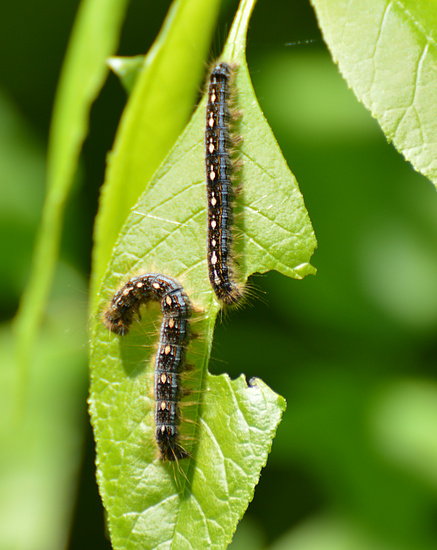
Forest Tent Caterpillars
I actually found them pretty up close.

Upland Sandpiper
This declining species bucks the usual habitat preference for sandpipers (in a word, wet) by favoring dry, open country with tall grass. Since unfarmed grassland is increasingly rare in eastern North America, Upland Sandpipers are also increasingly rare. At Franktown Road (one of just a few known spots for the species in Ottawa) we found this one flying around and perching on a power line, and heard, distantly, the strange, twittering "wolf whistle" that they use as a mating call.
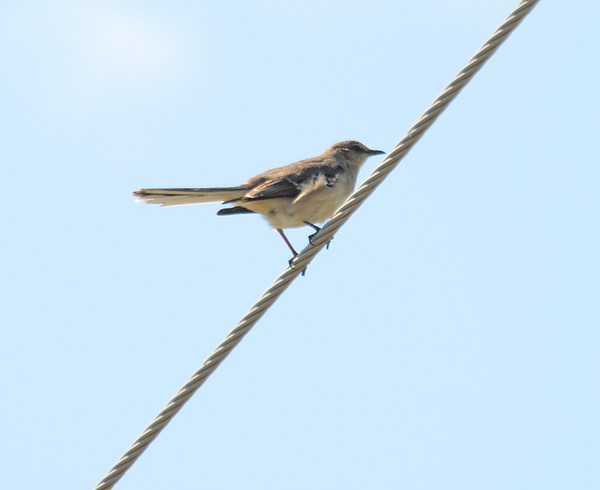
Northern Mockingbird
Seen on the drive to Murphy's Point. After the White Pelican, this was the rarest bird of the day.
July 6th, 2017
(Part 1)
After our stop to see the Ram's Head Ladyslippers, we went to Murphy's Point Provincial Park in Perth. This is a beautiful park on the shore of Big Rideau Lake with a rather Carolinian feel to it (including, sad to say, a rather Carolinian population of ticks, I pulled one off me during our walk.) It produced our big surprise of the day. We were birding the Silver Queen Mine Trail when Jon shouted that there was a White Pelican in flight and to get our binoculars and cameras ready. I couldn't believe my ears--I thought he must be mistaken--but then I got a clear view of it. A White. Pelican. Little over an hour away from where I live.
My photos came out overexposed (the exposure having been set for a cute moth I was photographing close to ground, more on him later!) and I was bummed. But then, as if our jaws hadn't dropped enough, the pelican flew back into view and right over our heads. This time I was ready.

When we first arrived, the park staff asked us to let them know if we found any rarities for the park. We found not merely a rarity, but a bird that is a second-ever for all Lanark County, in recorded history. White Pelicans are a western species whose breeding range touches only the extreme western tip of Ontario. This would have been a very lost, late spring migrant! It is an Ontario-first and a second-ever bird for me.
Other than that, my photo set from this trip might better be termed "insects and orchids." I saw plenty of good birds, but most of them too far away for my lens to capture at all well. (I envy those with steady-enough hands to shoot 500mm handheld!)

A kind of adorable furry-headed moth I found on some low vegetation. I think it's an Agreeable Tiger Moth. (That being, of course, a close relative of the Disagreeable Tiger Moth and the Cantankerous Tiger Moth. Okay, maybe not.) A lifer insect for me, to go with my lifer wildflower (Ram's Head Ladyslipper), lifer reptile (Rat Snake), and pretty-darn-close-to-lifer bird!

A daddy longlegs, more properly called harvestman. Harvestmen are not spiders and are harmless to humans. I've loved them since I was a child.
Our final stop of the day was Purdon Conservation Area, famous for its thriving colony of a large, beautiful wild orchid, the Showy Ladyslipper. But we arrived to find the orchids not yet in bloom. The many tall shoots promised an incredible show once they are. I plan to go back on my own (and/or with Michael) in late June, when they should be at peak. The carnivorous Pitcher Plants were also not much to look at yet. But there were a few wildflowers worth photographing.

Swamp Cinquefoil

Starflower
I've noticed quite a few tent caterpillars in Ottawa this spring, but that's nothing compared to Lanark County. Sites we visited had an infestation of epic proportions, with tents and caterpillars everywhere you looked. In the trees, in the bushes, on the ground, on your backpack, on your head. The deposit box for park fees at Murphy's Point had a mass of a few dozen crawling atop it. At one spot on the trail, we heard a sound like gentle, pattering rain coming from the woods. I learned what it was the next day on Wikipedia. It was the sound of umpteen caterpillar fecal pellets falling from the treetops.
Tent caterpillars are shunned by most birds, spiny as they are, but the North American cuckoos (Black-Billed Cuckoo and Yellow-Billed Cuckoo) eat them with relish. Quoting from Life Histories of North American Birds by Arthur Cleveland Bent:
No caterpillars are safe from the Cuckoo. It does not matter how hairy or spiny they are, or how well they may be protected by webs. Often the stomach of the Cuckoo will be found lined with a felted mass of caterpillar hairs, and sometimes its intestines are pierced by the spines of the noxious caterpillars that it has swallowed. Wherever caterpillar outbreaks occur we hear the calls of the Cuckoos. There they stay; there they bring their newly fledged young; and the number of caterpillars they eat is incredible. [...] When, in time, the inside of the bird's stomach becomes so felted with a mass of hairs and spines that it obstructs digestion, the bird can shed the entire stomach-lining, meanwhile growing a new one.
Yes, really. Cuckoos are so specialized to a diet of spiny caterpillars that they have evolved the ability to shed and regrow their entire stomach lining.
So it was a surprise to not see a single one amidst this massive infestation! Not even in what looked like ideal habitat. I'd certainly seen more cuckoos this spring in Ottawa than ever before. Before I'd even noticed the caterpillars, the tents, before it was on the public's radar that we were having an infestation, the cuckoos had noticed. I saw a pair of them together at Nortel wetland in May, a third at Shirley's Bay the day after that. These are elusive birds; it is abnormal (wonderfully abnormal) to see so much of them! But our Lanark outing came up empty, the only two of our target species that we missed entirely. They were undoubtedly there, but remained unseen and unheard.
So I had to content myself with photographing the prey, not the predator.

Forest Tent Caterpillars
I actually found them pretty up close.

Upland Sandpiper
This declining species bucks the usual habitat preference for sandpipers (in a word, wet) by favoring dry, open country with tall grass. Since unfarmed grassland is increasingly rare in eastern North America, Upland Sandpipers are also increasingly rare. At Franktown Road (one of just a few known spots for the species in Ottawa) we found this one flying around and perching on a power line, and heard, distantly, the strange, twittering "wolf whistle" that they use as a mating call.

Northern Mockingbird
Seen on the drive to Murphy's Point. After the White Pelican, this was the rarest bird of the day.
| ← | → |

mustangsallie
July 9th, 2017 at 11:29 pm
Great shot of the Pelican. He must have been right above your head. The little white furry moth is kinda cute (for a moth).
Suzanne
July 11th, 2017 at 6:44 pm
mustangsallie: You and I saw a White Pelican once at Outer Banks, in May 2013. Remember that huge white bird in the distance at Pea Island, so big it looked like a boulder to our naked eyes? That was my first.
mustangsallie
July 11th, 2017 at 8:33 pm
I remember it well. What a thrill it must have been to see one in your area!